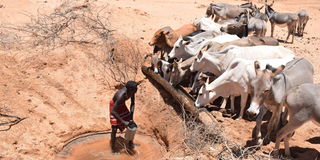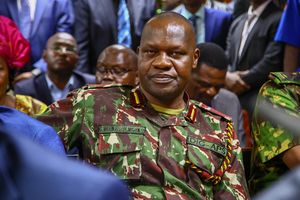Irrigate farms to beat drought, famine menace

A Samburu herdsboy watering livestock at Kom area on September 19, 2022. Experts attribute the grinding drought to climate change, warning that it might continue for a few more months.
What you need to know:
- Experts attribute the grinding drought to climate change, warning that it might continue for a few more months, perhaps towards year-end.
- Kenya requires urgent humanitarian intervention for short- and long-term solutions.
- There is a need to practise mixed farming for more food sources besides meat and milk.
The drought situation in the country is disconcerting with the arid and semi-arid (Asal) lands evidently overwhelmed.
The media is awash with stories of crestfallen locals over the death of their livestock and diminished food reserves that put human life at risk.
Experts attribute the grinding drought to climate change, warning that it might continue for a few more months, perhaps towards year-end.
Unreliable rainfall in the Asals makes them unsuitable for crop farming, hence absolute dependency on pastoralism for the sustenance of livelihoods.
The massive livestock deaths mark a monumentally tumultuous moment, hence an urgent need for a sustainable solution to the perennial problem.
For instance, in Kajiado, one of the counties in the alarm stage, the few dams there have dried up.
With no permanent rivers, pastoralists trek for many kilometres in search of water for their livestock.
That further weakens the animals and some die. The few remaining ones cannot fetch Sh3,000 for a cow that would normally sell for over Sh100,000.
Comparatively, Egypt, ideally a desert country, is more agriculturally viable than Kenya.
Statistics show it receives less than 200 millimetres of annual precipitation, far much lower than average Kenya’s Asals.
Human intervention has greatly eased the impact of drought in this Sahara Desert country, basically irrigation using River Nile waters.
Humanitarian intervention
Kenya requires urgent humanitarian intervention for short- and long-term solutions.
Drilling of community boreholes will provide water for both human use and livestock whenever dams dry up.
If the Asal county governments mobilised resources and drilled at least a borehole per sub-county, that would save pastoralists the arduous journeys.
There is a need to practise mixed farming for more food sources besides meat and milk.
Agriculture experts and researchers should educate the locals on smart farming and growing fast-maturing and drought-resistant crops.
On the Nairobi-Namanga Road are privately owned boreholes for large-scale (plantation) and subsistence (small-scale) irrigation at Isinya, Kumpa, Nkoile, Ilbissil and Maili-Tisa areas of Kajiado.
Were that replicated in other Asals, famine wouldn’t be as punishing.
Pastoralists should be enlightened to keep a manageable number of livestock.
It is preposterous to keep several hundred heads of cattle only for them to be wiped out by drought.
Charcoal burning thrives in this Nairobi Metropolis county. Without proper counter-deforestation policies, the area will soon lose its little vegetation cover, paving the way to bare ground, hence more drought.
Heavy financial investment is required to drill a borehole sufficient for a village, hence the need for the national and county governments and well-wishers to intervene and mobilise the requisite funds.
As the national government sets off to boost farm produce to reduce food prices, it ought to have strategies to address perennial famine in Asals. A hungry nation is an angry nation.
Mr Gisemba is a high school teacher, author and editor. [email protected].





